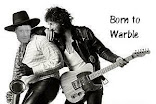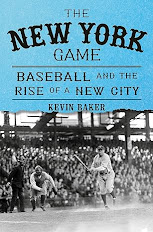I suppose it should not be a surprise that, in a country where, every day, more and more of the population chooses to live in whatever manufactured reality it likes, your New York Yankees have decided to reside wholly in their own fantasy land.
You can hear it on the team's broadcasts, where the broadcasters talk incessantly about "exit velo." The other day, Paul O'Neill even lamented the fact that some wonderful ballplayers of the past had not been able to play in these days of exit velo, when they would be truly appreciated.
Um, what?
The great players of yesteryear were appreciated for...results, not "exit velo" which is not a result or a statistical reality at all, but part of a play. Pitcher throws ball, batter hits ball, ball becomes out or hit or error. Exit velo is part of that process, but it is not a thing, not a finished reality in and of itself.
And yet, it is a vital part of the prevailing philosophy of the Yankees.
"Hit strikes hard" is the mantra of the Yanks' new hitting coach, Dillon Lawson (seen here leaving for his junior prom). A man who—judging by much of the gobbledygook many here have noted—would have been selling notions and elixirs at a traveling show in another time.One might as well say, "Throw balls well" or "Catch balls good."
But the idea that balls being hit hard means something in and of itself persists—even when they are hit right at people, or linger in the vasty deeps of the outfield, to be gathered in at leisure.
Meanwhile, as our Peerless Leader, El Duque, has pointed out, the Sabremetricious have decided to jettison the accumulated baseball wisdom of the last 160 years, such as putting guys who can run and make contact in the leadoff spot, and simply dismissing things like batting average.
Is any of this really thought out? Ever?
The new wisdom, for instance, is to put guys who draw a lot of walks into the leadoff position in the lineup, even if they are slow-footed power hitters (looking at you, Josh Donaldson!). Makes sense, right? Guys with high on-base percentages should bat more.
But have they really drawn a lot of walks in the past because they have a superior idea of the strike zone...OR because they have put in years batting between other power hitters, and often with runners already on base when they come up?
Are they really the same hitter, isolated at the top of the lineup?
Could it really be that the last 160 years are all wrong, and that having one behemoth coming up right after another—and often with some annoying jackrabbit or two already on base—did nothing to unravel pitchers?
Instead of fully exploiting their abilities, by making power hitters into leadoff hitters, aren't you really confusing their missions? That is, power hitters are supposed to try to swing for the big hit; they get a lot of walks because of that same fear that they can wreck the game with just one blow.
But if they're in a position where they are supposed to be getting on base as well as driving in runs...well then, which is it? Have we turned a happy side effect of power hitting—getting a lot of walks—into a primary mission, with all the confusion that is likely to bring...and a resulting drop in both walks and home runs?
Yet as in all things, the proven reality must be discarded in favor of the unreality.
Hence we get more and more fielding statistics that almost never agree with each other—in good part because they are measuring not what happened but what someone decides should happen; that is, how many plays any fielder is supposed to make.
Or even something as simple as the"left on base" stat that YES boxscores and others have decided to bizarrely redefine.
YES now adds up every time every batter fails to drive in a runner, and puts it into some frightening total at the end. The Yanks now routinely leave 20, even 29 guys on base a game.
This is not, traditionally, how LOB has been calculated, which was the total of all players left on base at the end of each inning. The change doesn't really matter...EXCEPT that is discards all the very necessary, traditional work of building runs.
Hence, a batter who lays down a sacrifice bunt, or who "gives himself up" to move a runner from second to third—something that should be a more vital skill than ever, in the age of the Manfred Man—has done something negative, leaving a runner on base, instead of something positive.
And here, I think, we get at what's wrong at heart with the New Statistics.
The subtle, unique reality of baseball is that it's an individual game hidden within a team game. The Sabremetricious keep trying to break it down into an individual game only—and a simplistic one at that.
Swing as hard as you can, throw as hard as you can, don't worry about building runs, or things like running or fundamentals or field smarts or doing well in the clutch (which doesn't exist!). You are only another statistical digit, without personality, character, or brains, and reality exists solely in the head of some mathematical wizard up in the team box.
But hey, what's reality, anyway?
Or to quote Jackson Browne's rendition of Rev. Gary Davis' "Cocaine Blues":
Now I'm losing touch with reality and I'm almost out of blow
Such a fine line, I hate to see it go.











































6 comments:
Amen, Hoss. You're preaching to the choir.
The hardest exit-velo hitter is no more of a ballplayer than the highest, loudest shrieking banshee is a singer or the hardest hitting puncher is a boxer.
No matter how hard you can hit the ball, you still have to make contact. And if you only make once in a blue moon, that's not good enough to be a champion.
No matter how high you can shriek or how loud, if you can't sing, you're not a singer.
No matter how hard you can punch a heavy bag, if you can't hit your opponent, you're not going to be a champion boxer.
HC, thanks for putting this so succinctly
That's hilarious, 999! I do tend to...digress.
But I love preaching to the choir. They're always so responsive!
Haven't even mention the double plays Hicks and others have hit it with multiple runners on base.Wonder what those exit velocities were?
Horace, that analysis was so sublimely deep that I wouldn't want to be in your shoes if the SABR researchers ever read it. Proof of the old bromide regarding "liars, DAMN liars, and statisticians". Well written! I estimate that the odds are 97% that you'll write another analysis that will equal this one.
Thanks, Kevin! And Unknown, great point. How can it be that this team still grounds into so many double-plays?
Post a Comment